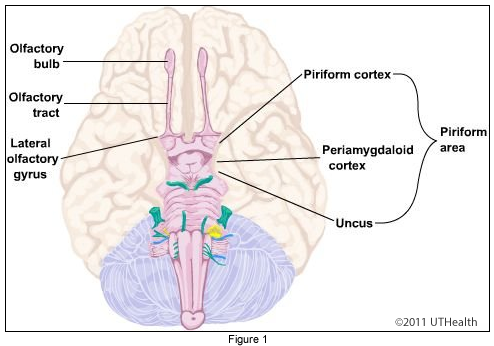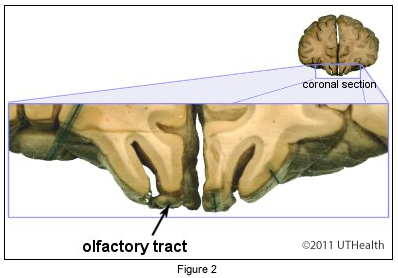Lab 7 (ƒ6) - Auditory, Vestibular, Gustatory and Olfaction Systems
The Central Olfactory System
 The olfactory pathway has classically been described to originate in the olfactory mucosa and to terminate in the piriform cortex. Fig. 1 illustrates the components of the olfactory pathway from the olfactory bulbs to olfactory cortex. Fig. 2 shows a coronal section through the lateral and medial olfactory tracts.
The olfactory pathway has classically been described to originate in the olfactory mucosa and to terminate in the piriform cortex. Fig. 1 illustrates the components of the olfactory pathway from the olfactory bulbs to olfactory cortex. Fig. 2 shows a coronal section through the lateral and medial olfactory tracts.
The olfactory receptor cells which number more than 100 million, serve as both the receptor cell and the 1° afferent neuron of this sensory system. The axon of the receptor cell passes through the cribiform plate of the ethmoid bone to end in theolfactory bulb (part of the telencephalon).
The olfactory tract branches at the olfactory trigone into the medial and lateral olfactory stria. The lateral olfactory stria is larger in humans and carries the 2° afferents to piriform and periamygdaloid cortex, and amygdala. The piriform cortex, sometimes also called the lateral olfactory gyrus, and the periamygdaloid area are considered to constitute the primary cortical olfactory receiving area. The entorhinal cortex is considered to be a secondary olfactory cortical area. Other connections considered as part of the limbic system will be covered in the Exercise on the Limbic System and Hypothalamus. The piriform cortex sends axons to the dorsomedial (DM) nucleus of the thalamus which, in turn, sends its axons to the orbital gyrus of the frontal cortex.

